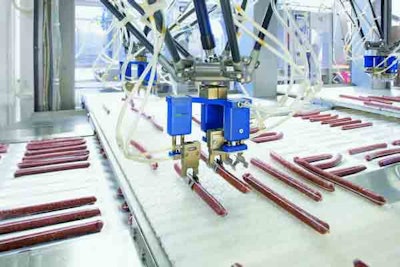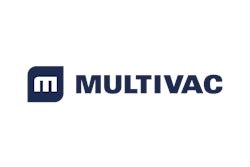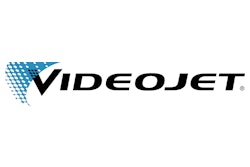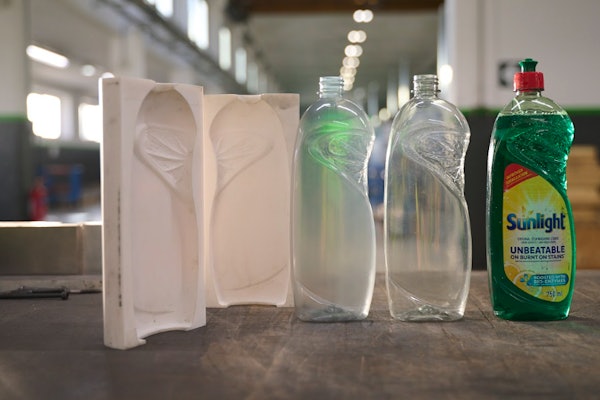
Seasonal promotions and other marketing initiatives designed to last briefly and change frequently are becoming increasingly important in the fast-moving world of consumer packaged goods. Consumers, too, want ever more variety in the size, shape, and flavor of the products they buy. That means today’s packaging lines must be more versatile than ever, and more often than not they’re gaining that versatility through robotics.
A perfect example can be found at the Unilever plant in
In operation since March, 2006, this is the second robotic packaging cell installed at the Ansbach plant. The first uses five delta-style robots to handle about 360 sausages/min. By comparison, the newest cell uses four robots instead of five and handles nearly 600 sausages/min. Permitting this surge in throughput and efficiency are improvements in both hardware and software. On the hardware side, the end effector on each robot is a triple-gripper. Each time it carries sausages to a thermoformed package, it does so three at a time.
Also notable is that only minor mechanical adjustments are required when Unilever changes to any of six sausage diameters. New parameters are chosen at a touchscreen and the pneumatically actuated mechanical grippers pretty much ready themselves for a new sausage diameter.
Nimble and sure-handed, the end-effectors were designed and built by Schunk (www.schunk.com) in collaboration with robomotion (www.robomotion.de), a specialist in robotics. Robomotion also had integration responsibilities on the robotic installation. One of robomotion’s key accomplishments was keeping the footprint of the robotic cell to a mere 2.5 x 3.5 m (8.20’ x 11.48’). Software played a key role in making this possible because it minimizes the distance that the robotic end effectors must travel. More on this later.
From cutting to packaging
Individual units of the sausage product are cut from long strings in a room adjacent to the packaging room. Their ultimate goal is to make their way into the thermoformed cavities produced in a multilayer forming web by an R530 system from Multivac (www.multivac.com).
This system forms, evacuates, and backflushes the packs before heat sealing lidding material into place.
A series of conveyors brings the sausages to a vibratory hopper that meters them onto two flat conveyors leading to the robotic cell. Running beneath and perpendicular to these conveyors is the multilayer forming web that has just emerged from the forming station of the Multivac R530 system. The four robots continually pick incoming sausages from the conveyor belts and place them into the rows of thermoformed cavities.
A Siemens (www.siemens.com) PC—plus ABB’s Pickmaster software—is the “brains” behind the robotic system. The PC learns the precise location of sausages on their infeed conveyor from a Cognex (www.cognex.com) vision system mounted at the infeed of the robotic cell. The PC sends to an ABB robotic controller the precise coordinates pinpointing sausage location. The ABB controller then determines the best strategy for one of the four robots to pick which sausages and when; the controller also determines into which thermoformed cavity sausages should be placed.
The number of sausages conveyed into the robotic cell exceeds the capacity of the four robotic heads. That way, the robots are never “starved” of incoming product. Besides, it’s inevitable that some sausages will land on the conveyor so close to each other that the robotic end effectors would have difficulty picking just one or the other. The Cognex vision system sees this condition and relays it to the Siemens PC, which in turn communicates with the ABB controller so that ultimately the robots will be steered to other, more readily picked, sausages. Sausages that don’t get picked tumble from the conveyor and are automatically recirculated back through the robotic cell again.
The exchange of information from vision system to PC to robotic controller takes place via an industrial Ethernet connection. ABB’s PickMaster software is a key tool used to tightly integrate the motion of the robots, the infeed conveyors, and the vision system. The powerful combination of robotics and vision brings great flexibility and an ability to make format changes quickly. According to Henrik Knobel, product manager at ABB, Cognex vision was chosen on the strength of its technology and because it offered efficient PC-software interfaces for integrating the vision functions in ABB’s robot technology. “Industrial vision technology gives a broad range of ABB robots the eyes to see where parts are located and to pick them accurately,” says Knobel.
The image processing system brings an added quality-control benefit. “Each individual product is measured and compared to a predetermined set of parameters,” says Torsten Ruetze, project engineer at Unilever. This provides a statistical record of how many pieces are too thick or long or thin or optically defective.
Software’s role
Additional software written by robomotion and running on the ABB controller also plays a key role. It executes what robovision’s Andreas Wolf calls “path planning.” He explains it this way.
“The Siemens PC is the brain that decides where the robots should go to pick the sausages,” says Wolf. “But the ABB controller, upon receiving that information from the PC, then decides the best paths for all four robots to take. It’s a bit trickier than usual in this particular case because, in order to keep the overall system footprint to a minimum, we designed it so that the robots’ paths sometimes overlap. Without the proper software programming, the robots would crash into each other.”
That they don’t crash into each other is one of the more remarkable things about watching the system work. Be sure to see the video footage.
Date-coding is handled by a bank of eight Videojet (www.videojet.com) ink-jet coders. Once past these coders, a cutting station separates individual packs from the web of material. Secondary packaging, for the time being, is done manually.
Once the thermoformed cavities are filled with sausages, they proceed to the station of the Multivac system that evacuates ambient air and backflushes each cavity with nitrogen before heat sealing the lidding material in place. Just ahead of this station is a second Cognex vision system that checks to see if any package is without product. If it finds one, a signal is sent to the downstream cutting station to prevent the cutting tools from cutting that group of packages from the web. An operator then places the uncut group aside. In this way, the empty cavity is prevented from making its way out of the plant.
Ruetze says the key contribution made by the robots is that they now allow the line to operate at optimal speed. He’s also pleased that it took only 10 days to get the system installed and put into commercial operation.
“This was an important project for us,” he adds.





























